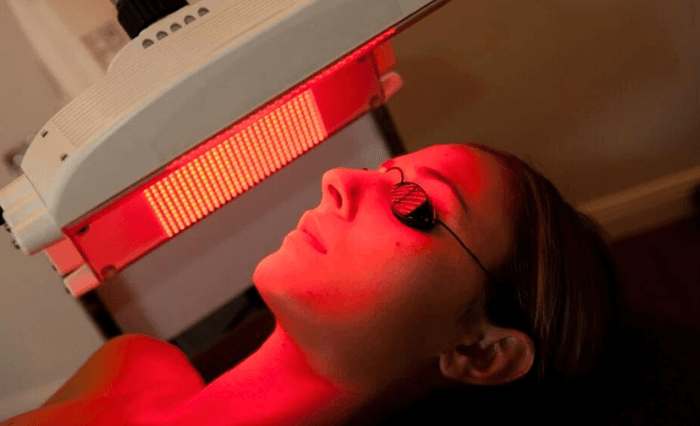Heal With Red Light
Discover Benefits of Red Light therapy.
Pain Relief


Anti-Aging
Red light penetrates the dermis layer, stimulating fibroblast activity, which produces collagen and elastin. Collagen supports the skin’s structure and elasticity, while elastin helps the skin resume its shape after stretching or contracting. Additionally, RLT reduces oxidative stress and inflammation, preventing the breakdown of skin proteins and slowing cellular aging.
Faster Healing
Red Light Therapy boosts ATP production in cells, providing them with the energy needed for repair and regeneration. It also enhances the proliferation of fibroblasts, which are essential for wound healing and collagen production. Increased angiogenesis, or the formation of new blood vessels, delivers more oxygen and nutrients to damaged tissues.


Reduced Inflammation
Hair Growth


Mental Well-Being
Skin Rejuvenation


Recovery (Post-Exercise & Injuries)
Performance Endurance


Blood Circulation
Hormone Optimization


Circadian Rhythm Regulation
Red Light Therapy can stimulate photoreceptors in the skin and eyes, influencing the production of melatonin and regulating the body’s internal clock. By improving sleep patterns, RLT optimizes the sleep-wake cycle and supports a healthy circadian rhythm. Improved sleep quality, reduced symptoms of insomnia, and enhanced daytime alertness. RLT can also help alleviate the effects of seasonal affective disorder (SAD) by positively influencing melatonin and serotonin levels.
Cancer Treatment
Red Light Therapy may help reduce the side effects of cancer treatments such as chemotherapy and radiation therapy by enhancing tissue repair and reducing inflammation. It also boosts immune system function, which can help the body target cancer cells more effectively.


Bone and Joint Health
Neurodegenerative Diseases
Red Light Therapy reduces oxidative stress and neuroinflammation in the brain, both of which contribute to neurodegenerative conditions like Alzheimer’s and Parkinson’s. It also enhances mitochondrial function in neurons, promoting synaptic plasticity and slowing neuronal degeneration.


Anxiety & Depression
Red Light Therapy enhances serotonin production and increases blood flow to brain regions involved in mood regulation, such as the prefrontal cortex. By improving mitochondrial function in neurons and reducing neuroinflammation, RLT balances neurotransmitter activity.
Neuropathy


Acne

Pain Relief
Red Light Therapy targets the mitochondrial chromophores, particularly cytochrome c oxidase, a key enzyme in the electron transport chain. By increasing ATP production and enhancing the function of pain-sensing neurons, RLT inhibits pain pathways in the nervous system. Additionally, RLT releases endorphins, the body's natural painkillers, and reduces oxidative stress that can exacerbate pain sensations.

Anti-Aging
Red light penetrates the dermis layer, stimulating fibroblast activity, which produces collagen and elastin. Collagen supports the skin's structure and elasticity, while elastin helps the skin resume its shape after stretching or contracting. Additionally, RLT reduces oxidative stress and inflammation, preventing the breakdown of skin proteins and slowing cellular aging.

Faster Healing
Red Light Therapy boosts ATP production in cells, providing them with the energy needed for repair and regeneration. It also enhances the proliferation of fibroblasts, which are essential for wound healing and collagen production. Increased angiogenesis, or the formation of new blood vessels, delivers more oxygen and nutrients to damaged tissues.

Reduced Inflammation
Red Light Therapy influences the NF-κB pathway, a key regulator of inflammation. By reducing the production of pro-inflammatory cytokines (e.g., TNF-alpha, IL-6) and increasing anti-inflammatory cytokines, RLT balances the inflammatory response. It also enhances mitochondrial function, which reduces oxidative stress and reactive oxygen species (ROS) that contribute to inflammation.

Hair Growth
Red Light Therapy promotes hair follicle stimulation by increasing mitochondrial activity in hair follicle cells. It prolongs the anagen (growth) phase of the hair cycle and reduces the telogen (resting) phase, leading to increased hair growth and thickness. Improved blood flow to the scalp nourishes hair follicles with essential nutrients.

Mental Well-Being
Red Light Therapy affects the prefrontal cortex, increasing cerebral blood flow and oxygenation to this area of the brain, which is associated with mood regulation and cognition. By enhancing mitochondrial function in neurons, RLT reduces oxidative stress and neuroinflammation, which are implicated in mood disorders.

Skin Rejuvenation
Red Light Therapy stimulates keratinocytes and fibroblasts, leading to increased production of collagen, elastin, and hyaluronic acid, all of which contribute to healthy, youthful skin. It also promotes epidermal cell turnover, replacing damaged or dead skin cells with new, healthy cells. By increasing blood flow to the skin, RLT enhances nutrient delivery and oxygenation.

Recovery (Post-Exercise & Injuries)
Red Light Therapy accelerates muscle repair and reduces muscle soreness by increasing ATP production in muscle cells. It also reduces levels of creatine kinase, a marker of muscle damage, and decreases pro-inflammatory cytokines in the damaged muscles. By enhancing blood flow, it helps flush out metabolic byproducts like lactic acid.

Performance Endurance
Red Light Therapy stimulates mitochondrial biogenesis, increasing the number of mitochondria within muscle cells, which boosts cellular energy output and endurance. Enhanced oxygen delivery to muscles, due to improved blood flow and vasodilation, helps delay fatigue during physical activity.

Blood Circulation
Red Light Therapy stimulates the release of nitric oxide, a molecule that relaxes blood vessels and promotes vasodilation. This enhances blood flow, delivering more oxygen and nutrients to tissues while removing waste products. Increased microcirculation supports better tissue health and repair. Improved circulation helps with healing wounds, reducing the risk of conditions such as peripheral artery disease, and enhancing overall cardiovascular health.

Hormone Optimization
Red Light Therapy modulates mitochondrial function in endocrine organs such as the thyroid and gonads. It helps improve cellular energy within hormone-producing cells, leading to optimized production of key hormones such as testosterone and thyroid hormones (T3, T4). Enhanced energy, libido, mood, and metabolic function. In men, RLT can increase testosterone levels, leading to improved muscle mass, mood, and energy.

Circadian Rhythm Regulation
Red Light Therapy can stimulate photoreceptors in the skin and eyes, influencing the production of melatonin and regulating the body’s internal clock. By improving sleep patterns, RLT optimizes the sleep-wake cycle and supports a healthy circadian rhythm. Improved sleep quality, reduced symptoms of insomnia, and enhanced daytime alertness. RLT can also help alleviate the effects of seasonal affective disorder (SAD) by positively influencing melatonin and serotonin levels.

Cancer Treatment
Red Light Therapy may help reduce the side effects of cancer treatments such as chemotherapy and radiation therapy by enhancing tissue repair and reducing inflammation. It also boosts immune system function, which can help the body target cancer cells more effectively.

Bone and Joint Health
Red Light Therapy stimulates osteoblasts (bone-forming cells) to enhance bone regeneration. It also reduces joint inflammation by decreasing pro-inflammatory cytokines and promoting collagen production, which supports joint cartilage

Neurodegenerative Diseases
Red Light Therapy reduces oxidative stress and neuroinflammation in the brain, both of which contribute to neurodegenerative conditions like Alzheimer’s and Parkinson’s. It also enhances mitochondrial function in neurons, promoting synaptic plasticity and slowing neuronal degeneration.

Anxiety & Depression
Red Light Therapy enhances serotonin production and increases blood flow to brain regions involved in mood regulation, such as the prefrontal cortex. By improving mitochondrial function in neurons and reducing neuroinflammation, RLT balances neurotransmitter activity.

Neuropathy
Red Light Therapy enhances the regeneration of peripheral nerves by reducing oxidative stress and inflammation around damaged nerves. It also stimulates mitochondrial function in nerve cells, promoting repair and reducing the sensation of pain or tingling associated with neuropathy.

Acne
Red Light Therapy has antimicrobial effects, particularly against Propionibacterium acnes, the bacteria responsible for acne. It also reduces inflammation in the skin and regulates sebaceous gland activity, decreasing sebum production, which clogs pores.
